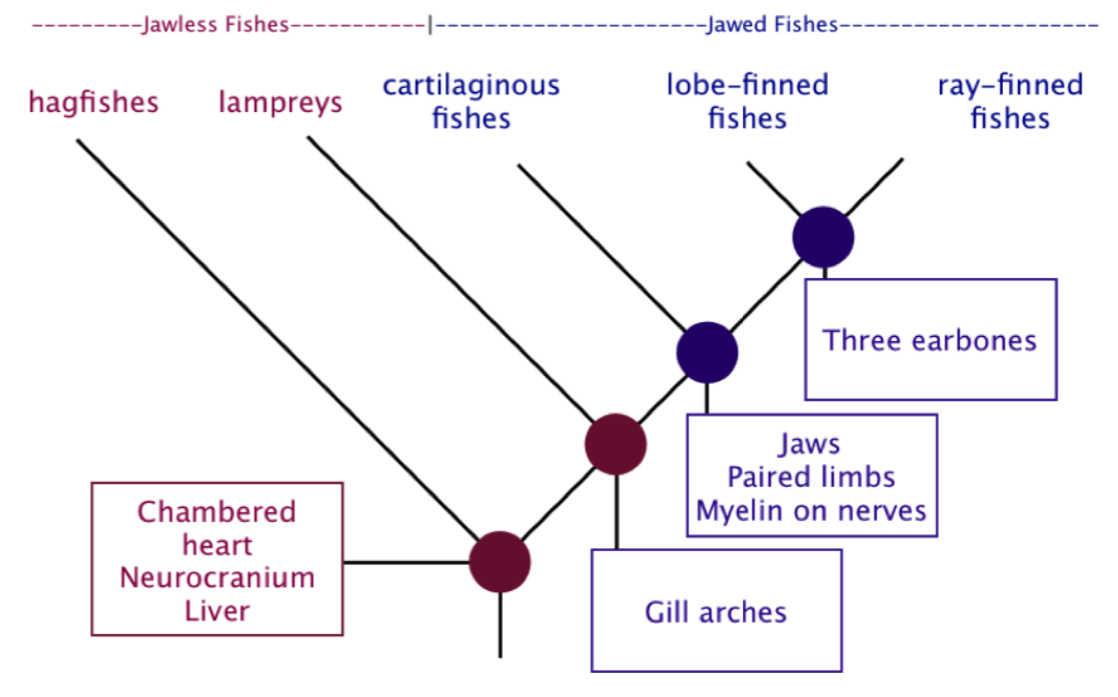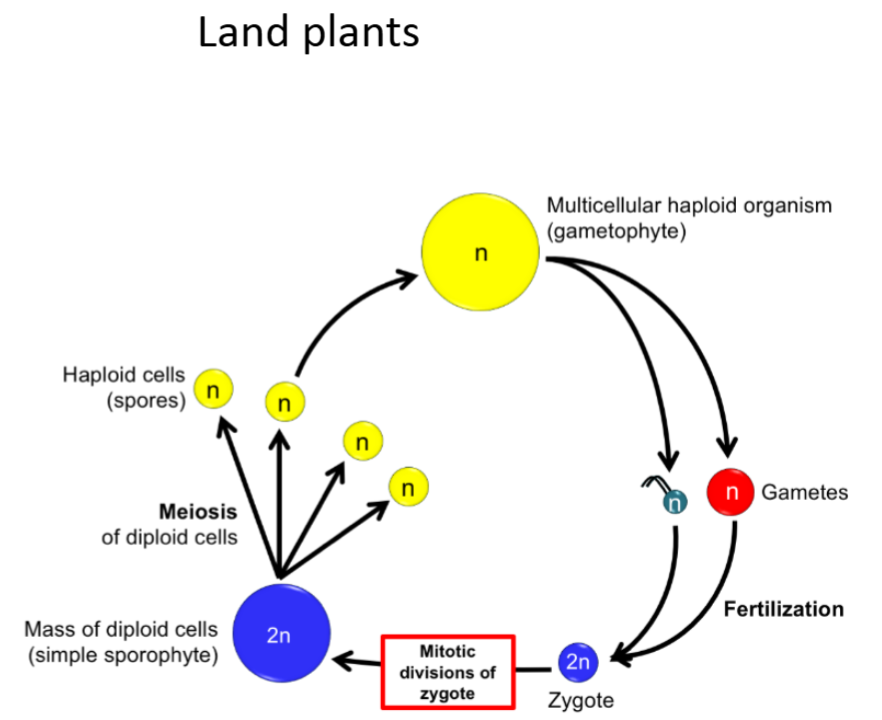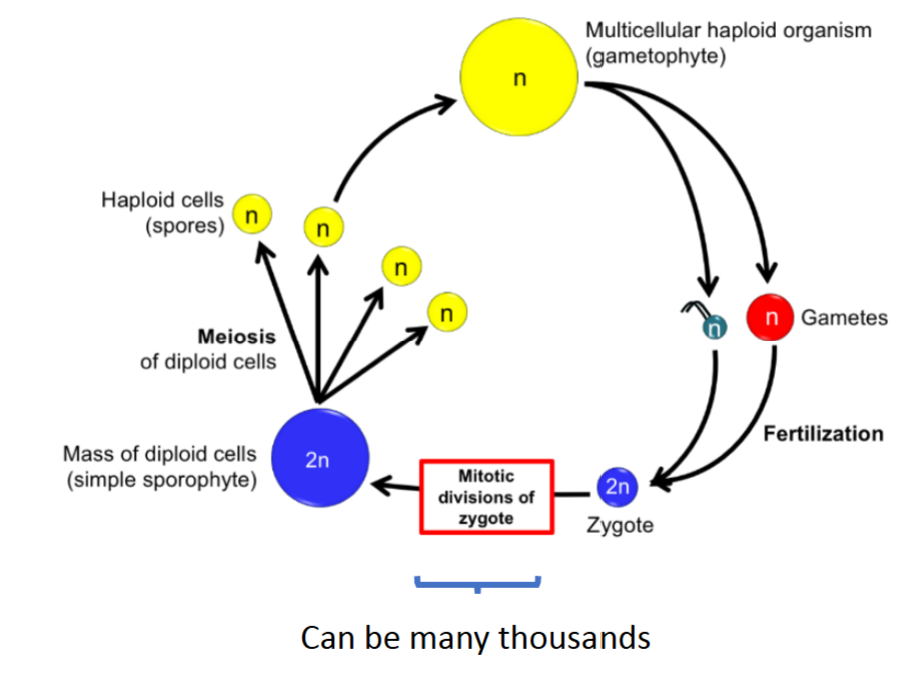W3 LECTURE 8: From the Cambrian to the Cretaceous
1/41
There's no tags or description
Looks like no tags are added yet.
Name | Mastery | Learn | Test | Matching | Spaced |
|---|
No study sessions yet.
42 Terms
Marine radiation of fishes
Cambrian saw the origin of Chordates
Fossil Agnatha – jawless fish, simple mouths and head morphology
Hagfish/lamprey of today
Benthic browsers/parasites
Silurian Diversification of fishes
450-420 Mya: jawed fish radiation ‘Gnathostomata’
Chondricthyes
Cartilaginous fish (Sharks and Rays) - No bones (cartilage instead)
Osteichthyes
Bony fish, Complicated structures - head/jaw
Ray-finned fish (Actinopterygii) - Teleosts
Lobe-finned fish (Sarcopterygii)- Coelocanth, lung fish, big
Evolutionary transition in fishes

Enabling feature: Genome duplication
Early chordates had two genome duplication events
four Hox gene clusters (allow position of body parts to be developed)
Enabled morphological complexity (jaws, limbs)
Algal life cycle
Haploid phase is dominant - one set of chromosomes
Haploids get together and create gametes
Gametes are fertilised to form a zygote
Zygote undergoes meiosis to form haploid cells

Land plant life cycle
Diploid phase started persisting
Zygote experienced mitosis
Mitosis in haploid and diploid

Byrophytes
Liverworts and Mosses
Long haploid phase, short diploid phase
No vascular tissue (xylem, phloem)
Don’t require soil
Evidence by fossilized sporangia
Mosses also evolved stomata – gas/water regulation (no vascular tissue)
Land plants accompanied by terrestrial fungi
Evolution of desiccation resistant fungal hypha from aquatic form
Hypothesized fungi enabled plant life on land through symbiosis
Water and ion gathering (origin of roots)
Fungal-plant interactions essential for many bryophytes
Fungi may have preceded plants into terrestrial environments
Plant death leads to organic-bearing terrestrial soil
Soil = breakdown of plant matter (fungal, microbial action)
Bryophytes do not ‘need’ soil but do create soil
‘paleosoil’ in the Devonian
Soil enables larger plants to grow higher
Soil stores water and mineral
Cooksonia
First vascular land plant (from soil development)
Phloem/Xylem transport system
(transport water/solutes)
Bifurcating (branching) growth
Increased size through Lignification (rigidity)
Leaves & fronds
Above ground photosynthetic surfaces
Evolved on multiple occasions - easy to evolve
Vascular plants life cycle
Extension of the diploid (sporophyte) phase
Short haploid phase
Thousands of mitotic divisions
Get long-lived organisms (trees)

Vascular plants to Richer soil
Deeper roots
Degradation of rock
Mineral release
PO4, NO3 are fuel for plant growth but run off may have ‘poisoned’ oceans via eutrophication
Leads to Devonian mass extinctions
(Mass extinction – many taxa disappear concurrently > 75% in 3 Mya)
What evolved from the carboniferous
All major plant taxa except flowering plants
Land plant evolution accompanied by terrestrial arthropods
First insects – flightless
Derived from Crustacea (in Silurian)
Devonian: Winged forms + Millipedes, Spiders (Aranaea)
Age of coal
Carboniferous rocks - Appearance of organic carbon rich deposits
Coal beds/measures - Shows plant death
Change in plant life
Coal beds have abundant plant (and other) fossils
Large, woody (lignified) plants appear alongside large ferns
Derived from lowland marsh/wetlands (anaerobic - no oxygen)
Why has the deposition of organic carbon increased
Tall Woody plants had become dominant
Wood is rigid and plants can be tall because of lignin (many C-C bonds)
Lignin = complex carbohydrate
Decomposes much more slowly, hard to break down
Slow decomposition was probably very slow when lignin first became ‘a thing’
This lead to more organic carbon being buried and coal strata forming
Consequences of increased organic carbon deposition
Rise in global O2
Oxygen cannot go back in respiration and carbon is stored
Rise in atmospheric oxygen
Biological consequences of increased organic carbon deposition
Insect gigantisms
Giant millipedes/cockroaches
Oxygen limiting body size
Amount of oxygen in water depends on temperature and salinity (cold/less saline holds more oxygen)
Colder and more saline environments hence produce larger organisms
O2 enables fire
Very common wildfires
Charcoal deposition from the coal means that carbon sink remains
Ecosystem stabilised by wet conditions
Carboniferous also saw radiation of tetrapods
Warm, wet climate, green terrestrial biome enabled movement out of water
Amphibian lifestyle – still linked to laying eggs in water
Closest ancestors = the lobe finned fish
Transitional form - Tiktaalik
Early forms: Ichthyostega, proto-legs
Giganticism seen in amphibia
Sole tetrapod group – dominant predators of the Carboniferous
The Permian
Rise of reptiles
End of the Carboniferous/early Permian saw a period of drying alongside a hot climate
One large land mass – Pangea/Gondwana
Drying makes a poor environment for amphibians
Selection for water retention
Reptiles form (first fossil, Hylonomus 318Mya)
Amniotic egg
Zygote in fluid filled capacity
Chorion and shell - able for gas exchange but retains water
Egg can be free from water
Reptile adaptations to live away from water
Keratinous scales - Water impermeable skin
Alteration in excretion
Uric acid
Utilize arid landscape areas
Internal fertilisation
Animals in water cam fertilise internally or externally
Reproduction on land leads to internal fertilisation
Evolution of metamorphis
Permian saw rise of metamorphosing insects
Drivers of metamorphosis are unsure
Permian mass extinction
End of the Permian saw largest mass extinction event in fossil record
‘The Great dying’
Causes of mass extinction
Occurred at same time as very high Volcanic activity in Siberia
Massive SO2, CO2 release
Ocean acidification
Reduced primary productivity
Death of consumers
Did not hit evenly and some species survived better
Reconstructing the biology of dinosaurs
Scientists study the new remains to determine relationships to other known species & genera
Comparisons are made between these and living animals reconstruct skeleton and lifestyle
Aspects such as size, movement, weight and shape can also be determined
Understanding the biology of extinct biology
Extend from understanding extant organisms to extinct ones:
Movement, running speed
trackways of footprints
Principles of anatomy, biomechanics
Thermal biology
SA/Volume ratio = retained heat
But can’t tell behaviour, e.g. basking, or metabolism
Or can we? Growth rates accelerate in endothermy
What has been discovered about dinosaurs
Diet is clear from teeth
Brain size scales with body size as for other reptiles
Likely did not have complex cognitive capacity of birds and mammals
Unclear how they reproduced
Origin of mammals
Mammals: c. 220 Mya
Derived from synapsids
(non-dinosaur reptiles, no living examples)
Remained a minor taxa during the age of dinosaurs
Hadrocodium
Hadrocodium - an extinct mammalia form
Lived during the Early Jurassic approximately 195 million years ago in what is now the Yunnan province in south-western China
Considered the closest relative of the class Mammalia
Very small
Insectivores, nocturnal (enabled by endothermy)
Maleus-incus-stapes derived from jawbone
Very good Hearing
Birds
c. 160 Mya
Evolved from theropod dinosaurs during the Jurassic (around 165–150 million years ago)
Classic small, lightweight, feathered, and winged body plan
Evolved gradually over tens of millions of years of evolution rather than one burst of innovation
Dinosaur-like
Tail with bones
Teeth
Bird-like
Feathers
Large brain
Descendants of the theropod group of dinosaurs
Birds are the only living dinosaurs, descended from the theropod group of dinosaurs
Theropods were two-legged, meat-eating dinosaurs that first appeared 231 million years ago
Angiosperm
Flowering plants
First fossils – 130 Mya
Fast growing compared to Gymnosperms (conifers)
Initially wind pollinated
Insect pollination c. 110Mya
Plant and insect diversification
Massive plant Diversification @ 70- 100 million years ago –> 250K species today
Loss of Gymnosperms in tropics
Diversification of beetles